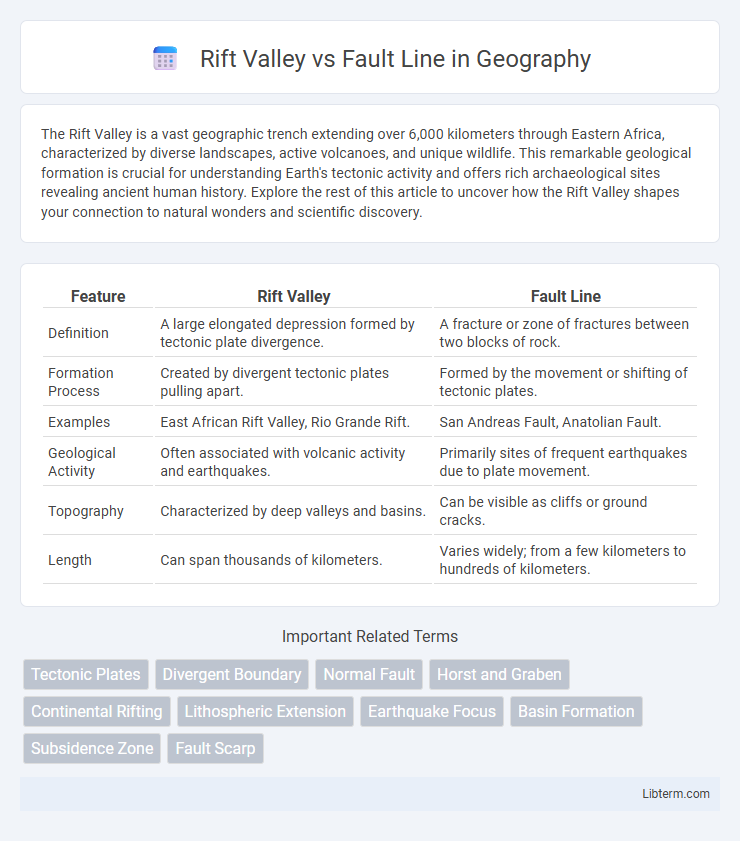The Rift Valley is a vast geographic trench extending over 6,000 kilometers through Eastern Africa, characterized by diverse landscapes, active volcanoes, and unique wildlife. This remarkable geological formation is crucial for understanding Earth's tectonic activity and offers rich archaeological sites revealing ancient human history. Explore the rest of this article to uncover how the Rift Valley shapes your connection to natural wonders and scientific discovery.
Table of Comparison
| Feature | Rift Valley | Fault Line |
|---|---|---|
| Definition | A large elongated depression formed by tectonic plate divergence. | A fracture or zone of fractures between two blocks of rock. |
| Formation Process | Created by divergent tectonic plates pulling apart. | Formed by the movement or shifting of tectonic plates. |
| Examples | East African Rift Valley, Rio Grande Rift. | San Andreas Fault, Anatolian Fault. |
| Geological Activity | Often associated with volcanic activity and earthquakes. | Primarily sites of frequent earthquakes due to plate movement. |
| Topography | Characterized by deep valleys and basins. | Can be visible as cliffs or ground cracks. |
| Length | Can span thousands of kilometers. | Varies widely; from a few kilometers to hundreds of kilometers. |
Introduction to Rift Valleys and Fault Lines
Rift valleys are elongated depressions formed by the divergent movement of tectonic plates, resulting in the thinning and sinking of the Earth's crust. Fault lines represent fractures or zones of fractures between two blocks of rock, where significant displacement has occurred due to tectonic forces. Understanding the distinctions between rift valleys and fault lines is essential for comprehending geological processes such as earthquakes, volcanic activity, and mountain formation.
Defining Rift Valley: Key Characteristics
A Rift Valley is a lowland region formed by tectonic plate divergence, characterized by a central depression flanked by steep cliffs or escarpments. It typically results from the pulling apart of the Earth's crust, creating a linear trough often accompanied by volcanic activity and seismic events. Unlike a fault line, which is a fracture along which displacement occurs, a Rift Valley encompasses a broader area shaped by extensive tectonic stretching and subsidence.
Fault Line Explained: Structure and Formation
Fault lines are fractures in the Earth's crust where tectonic plates meet and move, causing earthquakes and shifts in the landscape. These structures form through the accumulation of stress along plate boundaries or within plates, leading to breaks and displacement of rock layers. Fault lines vary in size and activity, playing a crucial role in shaping geological features and influencing seismic hazards.
Tectonic Processes Behind Rift Valleys
Rift valleys form as a result of tectonic plate divergence, where the Earth's lithosphere stretches and thins, causing the crust to break and sink between parallel faults. This extension process creates a linear depression bordered by steep fault scarps, distinguishing rift valleys from typical fault lines, which are fractures resulting from stress without significant crustal sinking. Key examples include the East African Rift Valley, exemplifying active continental rifting driven by mantle upwelling and plate tectonics.
How Fault Lines Form: Geological Insights
Fault lines form through the intense stress and strain caused by tectonic plate movements, where the Earth's lithosphere fractures and shifts along zones of weakness. These fractures, or faults, develop from the accumulation of tectonic forces such as compression, tension, or shear, leading to displacement of rock layers. Rift valleys specifically form when tensional forces cause the Earth's crust to thin and sink between parallel faults, creating a distinctive elongated depression.
Major Examples of Rift Valleys Worldwide
The East African Rift Valley is one of the most prominent rift valleys globally, stretching from Ethiopia to Mozambique and showcasing active tectonic plate divergence. The Baikal Rift Valley in Siberia, Russia, represents the world's deepest freshwater lake formed by rifting processes. The Rio Grande Rift in North America and the Rhine Rift Valley in Europe are significant examples highlighting continental rift systems associated with fault lines and crustal extension.
Notable Fault Lines Around the Globe
Notable fault lines around the globe include the San Andreas Fault in California, known for its significant earthquake activity due to the Pacific and North American plate boundary. The East African Rift Valley, a prominent example of a divergent tectonic boundary, is a vast rift system where the African Plate is splitting into smaller plates. The Himalayan Frontal Thrust represents a major convergent fault line impacting seismic hazards across the Indian subcontinent.
Differences in Formation: Rift Valley vs Fault Line
Rift valleys form through the process of tectonic plates pulling apart, creating a linear depression as the Earth's crust thins and sinks. Fault lines result from fractures where tectonic plates slide past or collide, causing displacement along the fracture without necessarily forming a valley. The key difference lies in rift valleys being characterized by crustal extension and subsidence, whereas fault lines represent zones of crustal movement and stress concentration.
Geological Impact: Rift Valleys Versus Fault Lines
Rift valleys form through the process of tectonic plates pulling apart, creating elongated depressions that can lead to new ocean basins and significant volcanic activity. Fault lines are fractures in the Earth's crust where blocks of land move past each other, frequently causing earthquakes and surface displacement. The geological impact of rift valleys involves large-scale crustal thinning and basin formation, while fault lines primarily result in seismic activity and localized terrain deformation.
Environmental and Human Implications
Rift valleys, formed by the divergence of tectonic plates, create fertile landscapes with rich biodiversity but pose risks like earthquakes and volcanic activity impacting local communities. Fault lines, characterized by fractures in the Earth's crust, often trigger seismic events that can lead to infrastructure damage and displacement of populations. Both geological features shape ecosystems and human settlement patterns, necessitating careful environmental management and disaster preparedness.
Rift Valley Infographic

 libterm.com
libterm.com